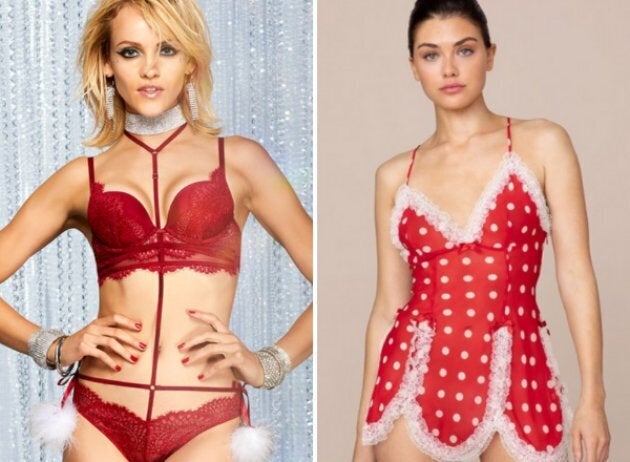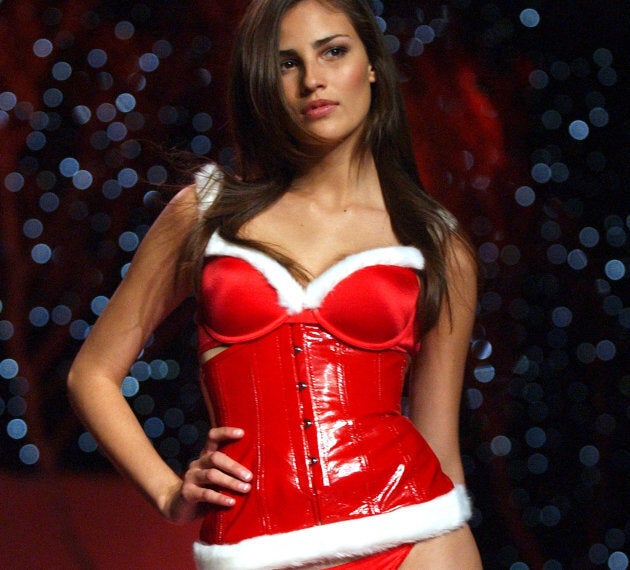
"Christmas is not sexy. Not at all," sex advice columnist Dan Savage said in a holiday episode of his podcast, "Savage Love," from several years ago. "F**king Arbor Day is sexier than Christmas."
For years, Savage has been waging a war on the eroticization of Christmas. In his view, a holiday celebrating the birth of a baby — and a virgin birth, at that — is hardly an occasion for lust.
But as any woman who has ever, say, been to a mall knows, there are a lot of people who have put a lot of money into convincing us otherwise. And one of the most pervasive and puzzling examples of the quest to make Christmas sexy is the ubiquity of Santa-themed lingerie.
Santa lingerie has so permeated our culture that anyone reading this can probably picture the garments in question: cherry-red bras with a white fur trim lining the cuffs, paired with matching panties, or maybe a red satin and white fur teddy.
And that's just the most basic, least creative iteration of the trend: chain retailer La Senza offers options including Push Up Santa Merrywidow, Santa Unlined Bra which they suggest pairing with Santa G-String Panty, and Santa Barely-There Bodysuit. These options are all fairly affordable — the most expensive item, the bodysuit, is $39.99 — but this is by no means a low-end trend. Under the "Christmas" section of its website, luxury lingerie brand Agent Provocateur offers a bright red mulberry silk slip with white polka dots and white lace trim for $680; the matching dressing gown is $815. (Several sizes are in limited stock, the store lets online shoppers know.)
When and how did lingerie evoking Santa, a wholesome and kindly childhood figure whose presence signals a religious virgin birth, get so popular?

Undergarments for women have long been costume-like, and were often meant to dramatically alter female silhouettes. (Think restrictive whalebone corsets, or giant hoops worn under crinoline skirts.) And even though bloomers or petticoats might look dowdy and utilitarian to us now, eroticizing lingerie isn't a new trend, either. Lingerie really started becoming more decorative and luxurious in the late 19th and early 20th centuries, according to Valerie Steel, who wrote the introduction to Collen Hill's 2014 book, Exposed: A History of Lingerie.
According to the corresponding exhibit at New York's Fashion Institute of Technology, there was such a "mania" for colourful, decorative and seductive lingerie throughout Europe that French journalist Octave Uzanne wrote in 1898 that "the last remains of feminine modesty sunk out of sight."
But underwear as literal costume is a newer phenomenon. It could be situated as a reverberation of the provocative "underwear as outerwear" period of the 1980s and 90s. At the end of the 20th century, seeing visible underwear became "more shocking than the nude body," said Kristina Haugland, associate curator of Costume and Textiles at the Philadelphia Museum of Art, in a public lecture in 2012 — she listed Madonna's "Blonde Ambition" cone bra as an example.
That's the culture that led up to the "fast fashion" lingerie that was so popular in the early 2000s. Haugland used a Victoria's Secret ad that said "fancy panties" are "fashion's newest accessory" as an example. This time period, of course, involved the reign of the Playboy bunny aesthetic, and it's also the era when the "slutty Halloween costume" went mainstream, according to a 2006 New York Times piece about the phenomenon.

And like those costumes, Christmas lingerie has its defenders and its detractors.
There are several reasons people might be interested in a sexualized Santa Claus, said Dr. Justin Lehmiller, a research fellow at the Kinsey Institute and author of Tell Me What You Want: The Science of Sexual Desire. Although he maintains that Christmas is "this wholesome family time," he also sees the same forces Dan Savage described that are attempting to sexualize Santa. "He's asking people to sit on his lap, he's keeping a naughty and nice list," Lehmiller told HuffPost Canada. "There are songs about Santa kissing women when he comes to visit." Maybe people who buy Santa lingerie are buying into the commercialized, sexualized lens of those forces.
But he said that for most people, the opposite is probably true: they likely still see Santa as a virtuous, child-friendly figure, and that transgression that norm is likely a big part of the appeal.
"I see that in my own work on sexual fantasies — taboo elements are one of the most popular things that people are fantasizing about," he said. "Christmas is a religious, moral, wholesome holiday, and this is a way of subverting that by adding a sexual element. Taking things that might be perceived as wholesome, and subverting them — that transgression, that taboo, is something that turns a lot of people on."

The roleplay element could be another part of the appeal, said Amy Pearson, co-founder of Toronto boutique Stole My Heart Lingerie. Her store doesn't carry this type of lingerie — their aesthetic is more minimal. "We don't find Santa particularly sexy," she said, although she was quick to add that she would never judge anyone who does.
"I think what it does is it incorporate that fun roleplay aspect that lingerie can have. I think it's just becoming a different person. Maybe it's Mrs. Claus, maybe it's Santa."
Pearson also noted that she's never received a request for Santa lingerie, although customers aren't shy about making other requests for products they'd like her store to carry.
"We've never been asked for it, so I think it's very niche," she said.
When something that was once a niche or fetish item crosses over into mainstream availability, it can sometimes send unconscious messages to consumers, according to some in the lingerie industry. The New York Times piece about "slutty Halloween costumes" quoted Deborah Tolman, the director of the Center for Research on Gender and Sexuality at San Francisco State University. In her research, many of the teenage girl she heard from said they understood the word "sexy" as meaning "being sexy for someone else, not for themselves." And when they were asked what made them feel sexy, Tolman told the newspaper they interpreted the question as "What makes you look sexy?"
Toronto designer Mary Young said part of the reason she started a lingerie line was because she never fit into the hypersexualized aesthetic of mainstream underwear brands. Looking at companies like La Senza or Victoria's Secret, "I always felt very alienated," she told HuffPost Canada.
"One of the most common things that I've seen in lingerie for as long as I can remember is this sort of childhood femininity that comes with it. The ideas of bows and lace, and women being packaged as a gift or a present, or an object." She feels that Santa lingerie plays into that: it's "a very youthful idea. We believe in Santa as children... It puts this asterisk on it, that anything can be sexualized.
When costumes of that kind become mainstream and women buy them simply because they're what's available, some degree of agency can be lost. "It's not allowing the wearer of the garment to be an individual person, but rather an object of someone else's fantasy."
More from HuffPost Canada:
It's important to think about where we're getting messages about what we consider sexy, Young said, and whether we're actually enjoying those messages. In terms of Santa lingerie — do women buy it for themselves, or for their partners? Their partner may not actually want this, either, she said. "It's just something that's been told to both men and women for generations, that this is what should be done."
There's one final reason people might like these outfits. Sexual behaviour tends to dip during the winter, but there's an exception right around the Christmas holidays, said Lehmiller.
"It may just be that people are a little hornier at this time of year," he said — regardless of what they're wearing.